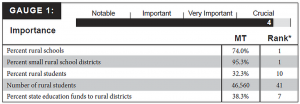Documents referenced at National Forum to Advance Rural Education and 110th NREA Convention and Research Symposium, October 11, 2018. Denver CO.
- Teacher Recruitment Strategies in Frontier Schools presentation.
- Why Rural Matter – Rural School and Community Trust
- Solving the Teacher Shortage – Learning Policy Institute
- MREA Recruitment and Retention Strategies v5/2018
- Predictability of Teacher Retention in Montana’s Rural Elementary Schools – Jilyn Oliveria (Chandler) Ed. D.
- Targeted Teacher Recruitment – Education Commission of the States
The video tells the story of MSU student Mary Hillerman, who is pursuing a career as a teacher in order to give back to Helmville, the small community that enriched her own life, according to Julie Kipfer, director of marketing and creative services for MSU’s University Communications. The ad follows the student’s journey from a small Montana school to enrollment at MSU and to her student teaching experience.
KTVH Mikenzie Frost Reports on Rural Education in Montana; charm, challenges and uncertainties
Click Here for Full Story.
Rural School and Community Trust
As a rural state, Montana is unique among all states particularly when it comes to education. The Rural School and Community Trust (RSCT) has been producing their Why Rural Matters every two years since 2009. From their latest report, Montana has the highest percentage of rural schools (74.0%) and the highest percentage of rural school districts (95.3%).
Here is a link to a portion of the report that is specific to Montana, Click Here. (9Mb)
Here is a link to the entire report RCST Report released in June of 2017, Click Here. (9Mb)
Other Publications of Interest from RCST are:
- Consolidation Research
- Distance Learning and Small Schools
- School Size Research
- School Size School Climate and Student Performance
- Small School Cost Effectiveness
- Anything But Research
The State of Funding Equity Data Tool
EdWeek Article – Teacher Recruitment and Retention is Complicated
EdWeek-Teacher Recruitment and Retention Is Complicated Jan-18
Learning Policy Institute – Understanding Teacher Shortages (9/16)
“The map below highlights a number of key factors that reflect and influence teacher supply and attrition and signal whether states are likely to have an adequate supply of qualified teachers to fill their classrooms. Based on these data—which treat compensation, teacher turnover, working conditions, and qualifications—each state is assigned a “teaching attractiveness rating,” indicating how supportive it appears to be of teacher recruitment and retention and a “teacher equity rating,” indicating the extent to which students, in particular students of color, are assigned uncertified or inexperienced teachers. Ratings are on a 1-5 scale, with 1 (the lightest color) being the least desirable and 5 (the darkest color) being the most desirable.”

